Key takeaways:
- Community engagement involves building genuine relationships and fostering open dialogue to enhance awareness and advocacy for animal welfare.
- Animal protection reflects societal moral values and is crucial for the well-being of both animals and communities, fostering a collective sense of responsibility.
- Engaging volunteers effectively requires recognizing their unique skills, providing clear roles, and fostering an inclusive environment that emphasizes individual contributions.
- Social media is a powerful tool for building awareness and creating conversations, enhancing community engagement through personal stories and targeted content strategies.
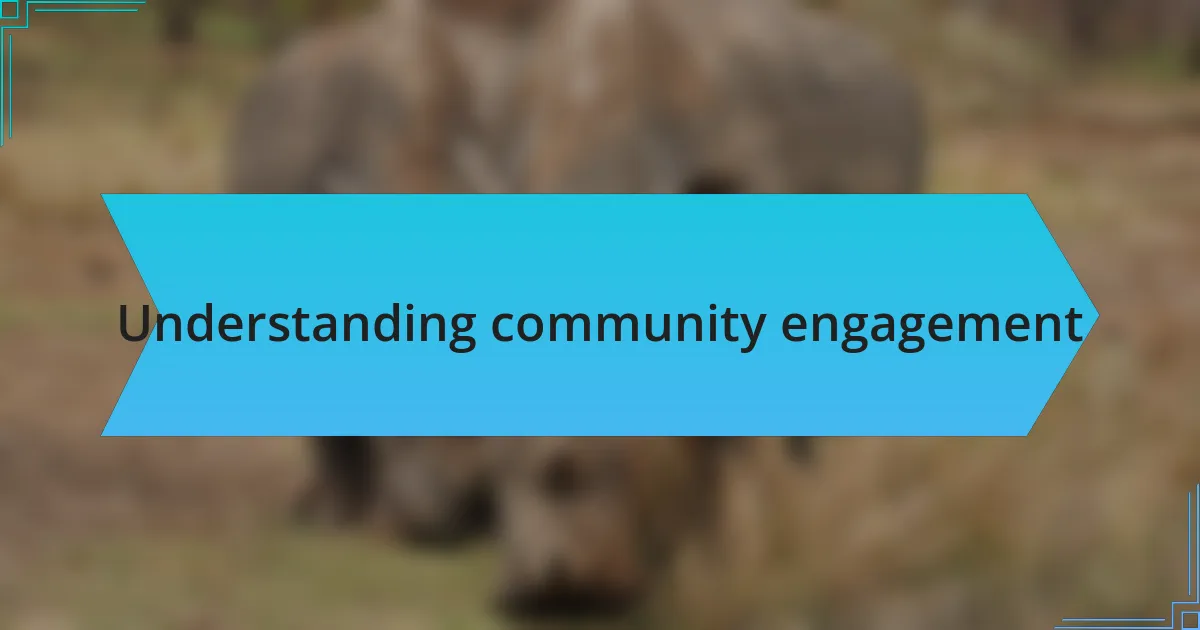
Understanding community engagement
Community engagement is more than just outreach; it’s about forging genuine relationships. I recall a time when I partnered with local pet owners to organize a pet adoption day. The joy and bonding that emerged from that event highlighted how when people come together for a common cause, the impact can be profound.
Effective community engagement necessitates listening as much as it does sharing. Have you ever considered how much people have to say about their experiences with animals in their lives? I’ve found that creating platforms for open dialogue not only informs our initiatives but also helps individuals feel valued and heard.
Additionally, community engagement can significantly enhance awareness around animal welfare issues. During one campaign, I was amazed at how discussions sparked by a simple post on social media encouraged local residents to become advocates for animal rights. It’s empowering to witness that together, we can create change, fostering a collective sense of responsibility.
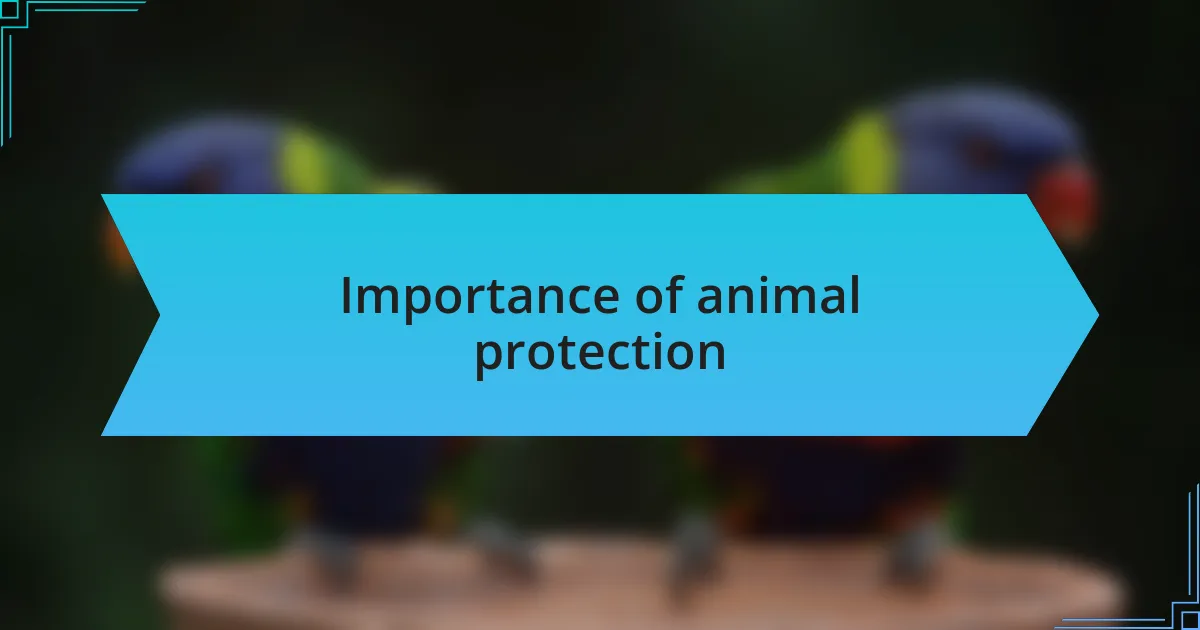
Importance of animal protection
Animal protection is crucial not just for the well-being of wildlife and pets, but it also reflects our moral values as a society. When I think about the times I’ve rescued animals, I can’t help but feel a surge of empathy for those voiceless beings. Have you ever witnessed the innocent eyes of an abandoned pet? The urgency to provide them with a safe home is both a responsibility and a profound honor.
Moreover, protecting animals impacts our environment and public health. I vividly remember an incident when a local farm was in jeopardy due to neglect, which endangered both the animals and the surrounding ecosystem. It became clear to me that our commitment to animal welfare extends beyond compassion; it directly affects the health of our communities. Isn’t it fascinating how intertwined our lives are with the animals around us?
Furthermore, advocating for animal protection can ignite a sense of community among people. I once joined a town hall meeting focused on a proposed animal shelter, and it was heartwarming to see neighbors rally together, sharing stories of their pets and discussing the importance of compassion. It reminded me that caring for animals isn’t just an individual effort; it’s a collective journey that brings us closer.
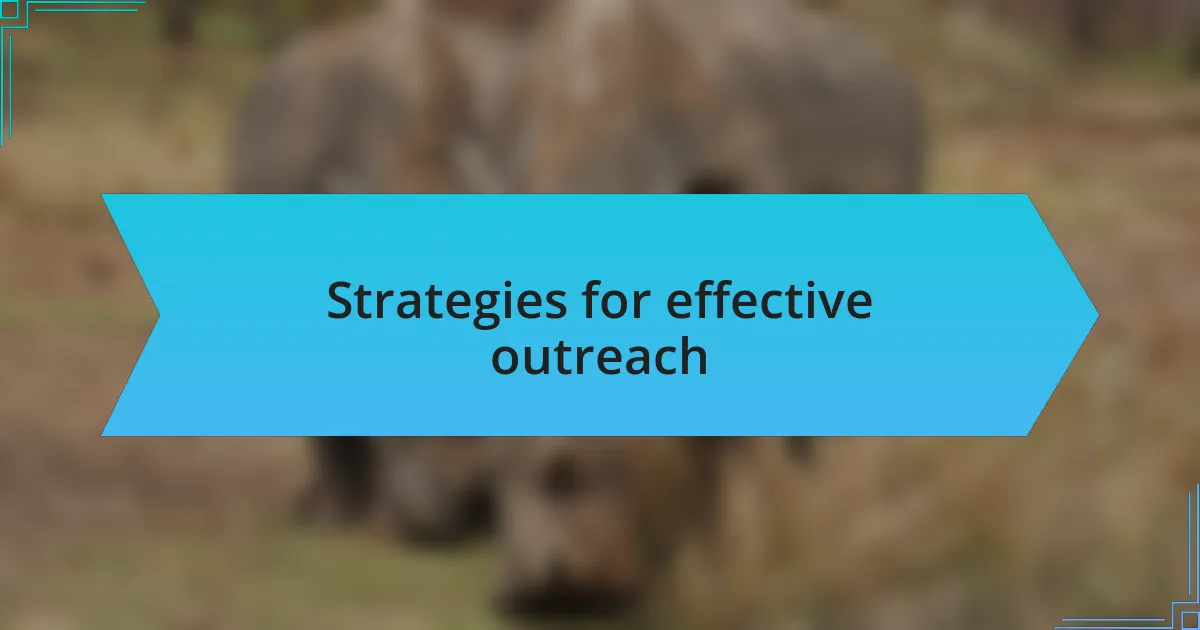
Strategies for effective outreach
One effective strategy for outreach is to leverage social media platforms. I’ve found that when I share stories of rescued animals or upcoming events, the response can be astonishing. Have you ever posted a touching photo of an animal in need and watched it spread like wildfire? That kind of engagement can build a community of advocates who feel personally invested in the cause.
Another method is organizing local events such as pet adoption days or fundraising walks. I remember my first time volunteering at an adoption event; the energy was electric. Seeing families connect with pets meant more than just finding homes; it was about fostering relationships within the community. These gatherings create a shared experience, encouraging participants to talk about animal welfare in their circles.
Direct outreach to local schools and community centers can also be incredibly impactful. One time, I participated in a workshop about responsible pet ownership for kids, and seeing their faces light up when interacting with animals was rewarding. Imagine how much empathy and understanding we can cultivate in future generations by starting these conversations early on. Isn’t it uplifting to think that through education and hands-on experiences, we’re planting the seeds of compassion in young minds?

Building partnerships with local organizations
When I consider building partnerships with local organizations, I often think of the strength that comes from collaboration. Once, I teamed up with a local veterinary clinic to offer free spay and neuter clinics for underserved communities. This partnership not only provided essential services to the public but also strengthened our ties within the community. Have you ever witnessed how two organizations can amplify each other’s efforts in a way that truly benefits the cause?
Finding common goals is crucial when establishing these partnerships. I recall working alongside a local environmental group, which focused on habitat preservation. Together, we organized a community cleanup event that highlighted the connection between clean habitats and the well-being of local wildlife. It was amazing to see participants realize how their actions impact not just their surroundings but also the animals we strive to protect. Does that make you think about the broader implications of our work?
Moreover, mutual support can foster trust and create a network of advocates. I remember attending a fundraising gala hosted by a nearby animal shelter, where they recognized our collaborative efforts in rescue operations. The genuine gratitude shared between organizations was palpable, and it motivated me to engage even more deeply in our mission. How can we overlook the power of acknowledgment and appreciation in nurturing these relationships?
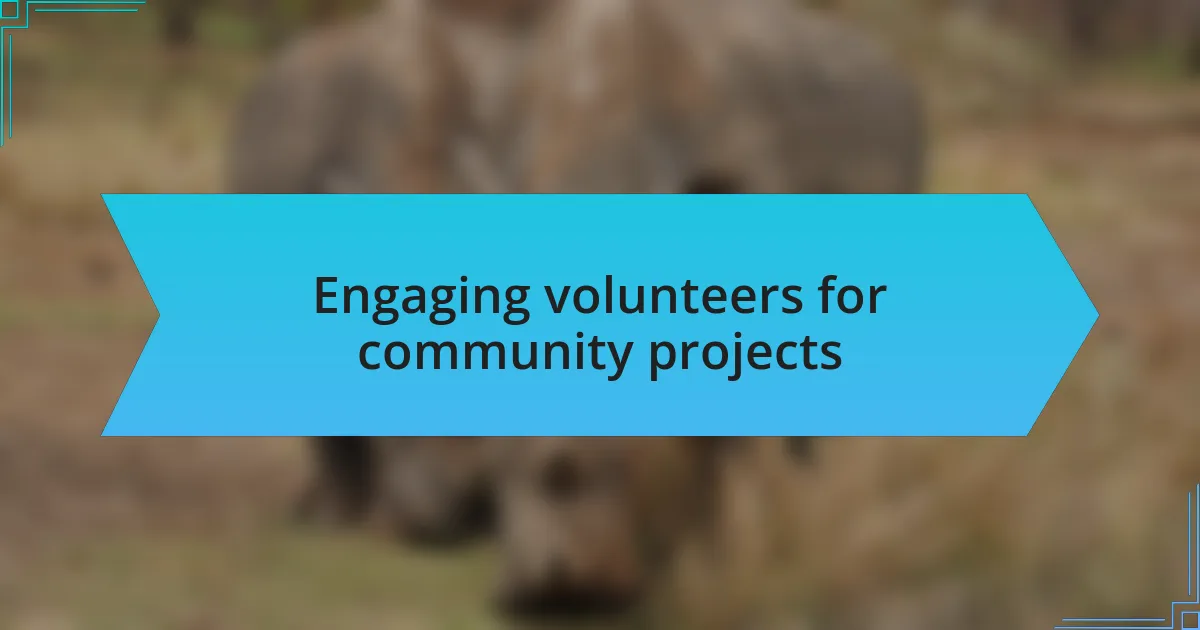
Engaging volunteers for community projects
Engaging volunteers for community projects requires a thoughtful approach that makes them feel valued. I remember one time when I organized a volunteer orientation session that emphasized the impact each person could have on local animal welfare. When I saw the passion in their eyes as they realized their potential to make a difference, it reaffirmed my belief in the power of community involvement. Have you ever felt that spark when you know you’re part of something bigger than yourself?
It’s also essential to recognize the unique skills that volunteers bring to the table. During a recent fundraising event, I discovered that one volunteer was a graphic designer. By harnessing that creativity, we transformed our marketing materials into something truly captivating. It’s incredible to think how tapping into each person’s strengths not only enriches our projects but also boosts their confidence and engagement. Doesn’t it feel great to use individual talents for a collective goal?
Moreover, providing clear roles and responsibilities can significantly enhance volunteer commitment. I vividly recall a time when I assigned specific tasks during a community clean-up. The volunteers felt empowered and took ownership of their roles, which made the entire event run smoothly. Do you see how clarity in expectations can lead to more satisfying and effective volunteer experiences? Each of these elements, when woven together, can create a thriving volunteer community that drives meaningful change.

Leveraging social media for awareness
Social media has become a vital tool in raising awareness for animal protection. I vividly recall a campaign we launched on Instagram featuring rescued animals, where we not only shared their stories but also encouraged followers to engage by sharing their own experiences. The flood of personal anecdotes in the comments created a virtual community that united animal lovers, reinforcing the message that we’re all in this fight together. Do you ever wonder how a simple hashtag can spark such meaningful connections?
In my experience, leveraging social media isn’t just about broadcasting information; it’s about creating conversations. During one campaign, I posed an open question about animal welfare challenges in our local area. The responses were eye-opening, as people shared their stories and proposed solutions. This back-and-forth dialogue not only spread awareness but also made participants feel authentically involved in the cause. Have you noticed how the power of storytelling can elevate community engagement?
Moreover, utilizing social media analytics can sharpen our outreach strategies. After tracking engagement metrics from a recent awareness post, I saw that visuals of happy, adopted pets resonated more than text-heavy updates. This insight has shaped our content strategy, focusing on heartwarming visuals that not only attract attention but also inspire action. Isn’t it fascinating how data can guide us to connect with our community on a more personal level?
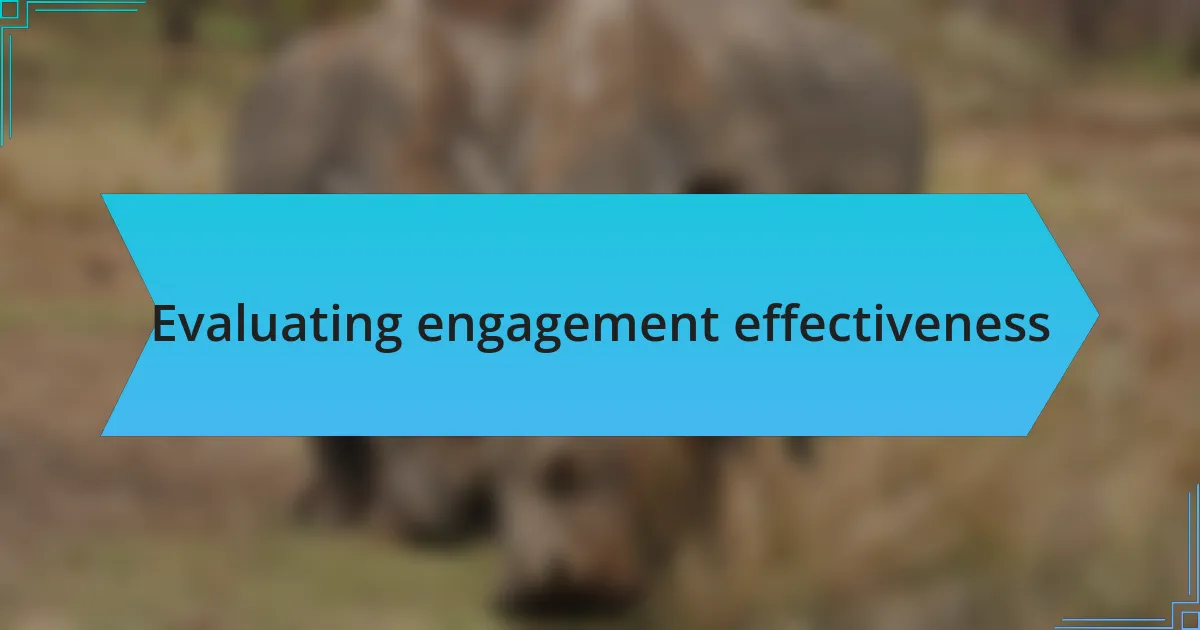
Evaluating engagement effectiveness
To evaluate our engagement effectiveness, I often turn to direct feedback from our community. Recently, we conducted a survey asking participants what aspect of our campaigns resonated with them the most. It was surprising to discover that many cherished the sense of community we fostered, which reminds me of how important it is to not only measure numbers but also to understand the emotions behind them. Have you ever felt that rush of excitement when your voice is heard?
Another method I find valuable is analyzing engagement trends over time. For instance, during a recent fundraiser, I noticed a marked increase in participation when we shared behind-the-scenes stories about the animals we support. This shift not only boosted our donations but also reaffirmed my belief that transparency builds trust. Isn’t it intriguing how a genuine peek into our work can motivate others to contribute?
Lastly, I consistently monitor the effectiveness of our calls to action. One time, we rephrased our request for support from a simple “Donate” to “Join us in creating a better world for these animals.” The increase in response was noticeable. This experience taught me that language matters—how we frame our requests can ignite passion and drive engagement. Have you considered how your wording might impact your audience’s response?